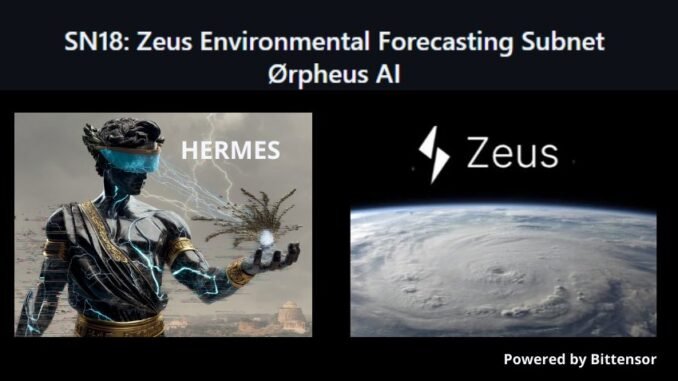
Here’s a great article by Punisher highlighting the decentralized edge of Zeus subnet, the MoE model powering their API:
Introduction
Weather forecasts are not just a convenience: they save lives, protect billions in assets, and guide decisions across sectors such as agriculture, energy, logistics, and financial markets. Yet, traditional forecasting models, centralized, heavy, and costly, are reaching their limits in the face of increasing climate complexity.
This is where Zeus (SN18) comes in, a Bittensor subnet developed by Ørpheus AI. By combining machine learning and decentralization, Zeus is building the most accurate, scalable, and transparent weather forecasting network ever designed.
Why Decentralize Weather?
Traditional centralized models rely on massive supercomputers and a single approach. This limits their adaptability and effectiveness in a world where weather events are increasingly unpredictable.
In contrast, Zeus leverages a global network of miners, each developing their own AI model with a unique specialization: some perform better for short-term forecasts, others for specific regions or variables (temperature, precipitation, etc.).
At the core of this architecture is the Mixture of Experts (MoE) model.
The Zeus API selects in real time the most reliable forecasts from all miners for each request.
The result: contextual forecasts that are more robust and accurate than any single centralized model.
Zeus’s MoE is not just a passive aggregator. For each query, it dynamically selects the most relevant miners based on their expertise (short-term, specific region, particular variable such as temperature or rainfall). This ensures the best contextual forecast every time.
Unlike centralized systems that rely on a single global model, Zeus harnesses diversity and competition among miners, continuously improving accuracy.
In one sentence: weather is too complex to be left to a single centralized model, Zeus proves that a decentralized intelligence, orchestrated by a dynamic MoE, delivers superior forecasts.
In short: weather is better predicted when it is decentralized.
Architecture and Workflow
Zeus’s operation relies on three main roles:
- Miners: train forecasting models using historical climate data (notably ERA5 from Copernicus) and return predictions for specific locations and time horizons.
- Validators: send challenges (location, horizon, variable), compare results with ground truth data, and distribute rewards.
- Subnet (SN18): manages governance and expands the set of environmental variables to be predicted.
The process follows three steps:
- A validator sends a challenge (e.g., forecast 2m temperature in Paris, starting 48 hours from now, for a specified period).
- A miner responds with its prediction.
- The validator compares with the ground truth (ERA5) and assigns a difficulty-adjusted reward.
Incentives are based on a difficulty-weighted RMSE: predicting in stable areas (like the Pacific Ocean) pays less than forecasting in complex regions (mountains, tropics). This discourages cherry-picking and encourages miners to tackle the hardest cases.
Validators themselves only need a decent CPU and 8GB RAM, making the system highly accessible.
Performance: Zeus Outperforms Reference Systems
The results published by the team and confirmed across multiple… [READ THE FULL ARTICLE]




Be the first to comment